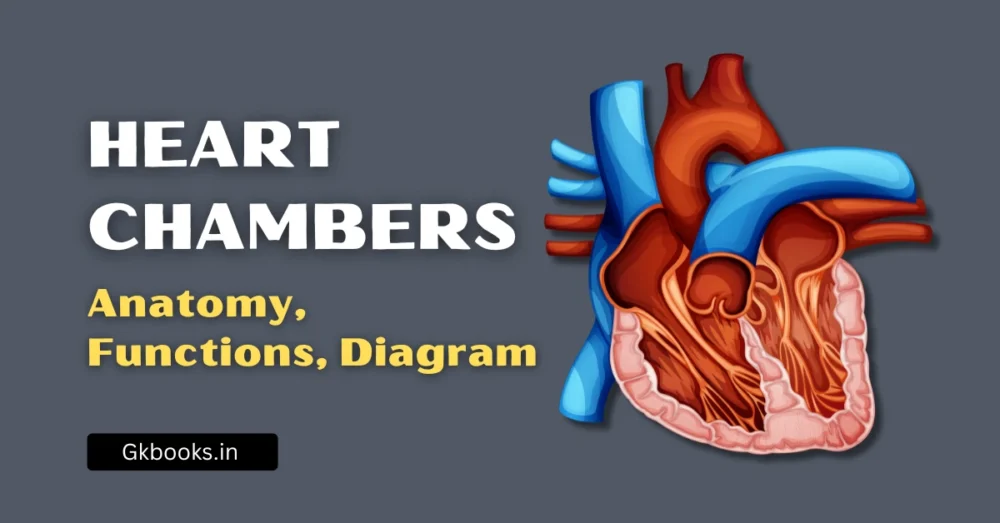The aorta is the largest artery in the human body, emerging from the left ventricle of the heart. Its primary function is to carry oxygenated blood from the heart and distribute it to all parts of the body through systemic circulation.
👉 Why important for exams?
Questions on the aorta are frequently asked in General Science, Biology, and Human Physiology sections of UPSC, SSC, Railways, Banking, and State PSC exams. Since the aorta is central to the circulatory system, its structure and function are high-yield topics.
Structure of the Aorta
The aorta is a thick, elastic, and muscular artery that ensures efficient blood flow.
Parts of the Aorta
- Ascending Aorta – Starts from the left ventricle.
- Arch of Aorta – Curved portion that gives off branches to the head, neck, and arms.
- Thoracic (Descending) Aorta – Supplies blood to the chest and upper abdominal region.
- Abdominal Aorta – Extends downwards to supply lower abdomen, pelvis, and legs.
🔹 Key Fact: The aorta is about 30–35 cm long and 2–3 cm in diameter in adults.
Functions of the Aorta
1. Distribution of Oxygenated Blood
- Carries oxygen-rich blood from the left ventricle to the entire body (except lungs).
- Supplies blood to head, neck, arms, abdomen, pelvis, and legs through its branches.
2. Maintains Blood Pressure
- Elastic walls of the aorta stretch during ventricular systole (when heart contracts).
- During diastole (when heart relaxes), the elastic recoil helps maintain continuous blood flow and stable pressure.
3. Branching into Major Arteries
The aorta gives rise to several major arteries:
- Ascending Aorta → coronary arteries (supply heart muscles).
- Aortic Arch → brachiocephalic artery, left common carotid artery, left subclavian artery.
- Descending Thoracic Aorta → chest & thoracic organs.
- Abdominal Aorta → renal arteries, mesenteric arteries, iliac arteries.
4. Acts as a Pressure Reservoir
- Stores kinetic energy of blood flow during systole.
- Releases it in diastole, ensuring smooth and non-pulsatile flow in capillaries.
5. Nutrient & Oxygen Supply
- Ensures delivery of oxygen and nutrients to all tissues (except lungs, which are supplied by pulmonary arteries).
Exam-Oriented Key Facts
- Largest artery in the body.
- Originates from the left ventricle.
- Four major parts: Ascending, Arch, Thoracic, Abdominal.
- Functions: Conduction, Distribution, Elastic recoil.
- Related to Windkessel effect (continuity of blood flow).
Clinical Relevance (Case Studies)
Understanding the aorta is also important in a real-life medical context.
- Aortic Aneurysm – Bulging of the aortic wall (can be fatal).
- Aortic Dissection – Tearing of the inner wall of the aorta, causing severe internal bleeding.
- Coarctation of Aorta – Congenital narrowing, leading to hypertension.
👉 Such conditions are often used in applied science questions in UPSC and Defence exams.
PYQ (Previous Year Questions)
SSC/UPSC/State PSC
- Q: Which is the largest artery in the human body?
Ans: Aorta. - Q: From which part of the heart does the aorta arise?
Ans: Left ventricle. - Q: The Windkessel effect is associated with which blood vessel?
Ans: Aorta.
Expected Questions
- Name the four parts of the aorta in sequence.
- Write two primary functions of the aorta.
- Match the following:
- Arch of Aorta → Head and Neck
- Abdominal Aorta → Lower limbs
Quick Revision Points (Summary)
- Aorta = Largest artery, ~30–35 cm long.
- Origin: Left ventricle of heart.
- Parts: Ascending → Arch → Thoracic → Abdominal.
- Function: Carries oxygenated blood, maintains pressure, and ensures continuous flow.
- Exam Questions usually cover structure, function, and clinical importance.
✅ Final Tip for Exams:
Always remember that the aorta = distribution + continuity + pressure maintenance. Any MCQ around these keywords is most likely linked to the aorta.
Read More:
Heart Chambers: Anatomy, Functions, Diagram & Exam-Focused Notes
Vitamin Deficiency Diseases – Causes, Symptoms, Sources & Exam-Focused Notes
Function of the Stomach in the Human Body: Key Roles, Mechanisms & Importance






